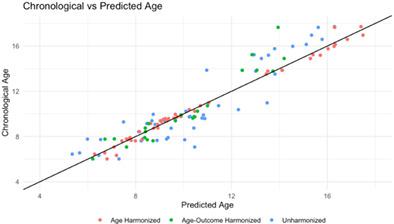当前位置:
X-MOL 学术
›
Hum. Brain Mapp.
›
论文详情
Our official English website, www.x-mol.net, welcomes your feedback! (Note: you will need to create a separate account there.)
Maturity of gray matter structures and white matter connectomes, and their relationship with psychiatric symptoms in youth
Human Brain Mapping ( IF 4.8 ) Pub Date : 2021-07-09 , DOI: 10.1002/hbm.25565 Alex Luna 1, 2 , Joel Bernanke 1, 2 , Kakyeong Kim 3 , Natalie Aw 1, 2 , Jordan D Dworkin 1, 2 , Jiook Cha 1, 3, 4, 5 , Jonathan Posner 1, 2
Human Brain Mapping ( IF 4.8 ) Pub Date : 2021-07-09 , DOI: 10.1002/hbm.25565 Alex Luna 1, 2 , Joel Bernanke 1, 2 , Kakyeong Kim 3 , Natalie Aw 1, 2 , Jordan D Dworkin 1, 2 , Jiook Cha 1, 3, 4, 5 , Jonathan Posner 1, 2
Affiliation

|
Brain predicted age difference, or BrainPAD, compares chronological age to an age estimate derived by applying machine learning (ML) to MRI brain data. BrainPAD studies in youth have been relatively limited, often using only a single MRI modality or a single ML algorithm. Here, we use multimodal MRI with a stacked ensemble ML approach that iteratively applies several ML algorithms (AutoML). Eligible participants in the Healthy Brain Network (N = 489) were split into training and test sets. Morphometry estimates, white matter connectomes, or both were entered into AutoML to develop BrainPAD models. The best model was then applied to a held-out evaluation dataset, and associations with psychometrics were estimated. Models using morphometry and connectomes together had a mean absolute error of 1.18 years, outperforming models using a single MRI modality. Lower BrainPAD values were associated with more symptoms on the CBCL (pcorr = .012) and lower functioning on the Children's Global Assessment Scale (pcorr = .012). Higher BrainPAD values were associated with better performance on the Flanker task (pcorr = .008). Brain age prediction was more accurate using ComBat-harmonized brain data (MAE = 0.26). Associations with psychometric measures remained consistent after ComBat harmonization, though only the association with CGAS reached statistical significance in the reduced sample. Our findings suggest that BrainPAD scores derived from unharmonized multimodal MRI data using an ensemble ML approach may offer a clinically relevant indicator of psychiatric and cognitive functioning in youth.
中文翻译:

灰质结构和白质连接组的成熟度及其与青年精神症状的关系
大脑预测年龄差异或 BrainPAD 将实际年龄与通过将机器学习 (ML) 应用于 MRI 大脑数据得出的年龄估计值进行比较。青少年的 BrainPAD 研究相对有限,通常只使用单一的 MRI 模式或单一的 ML 算法。在这里,我们使用多模态 MRI 和堆叠集成 ML 方法,该方法迭代地应用多种 ML 算法 (AutoML)。健康大脑网络的合格参与者(N = 489) 分为训练集和测试集。形态测量估计、白质连接组或两者都输入 AutoML 以开发 BrainPAD 模型。然后将最佳模型应用于保留的评估数据集,并估计与心理测量学的关联。使用形态测量和连接组的模型的平均绝对误差为 1.18 年,优于使用单一 MRI 模式的模型。较低的 BrainPAD 值与 CBCL 上的更多症状 ( p corr = .012) 和儿童全球评估量表上的较低功能 ( p corr = .012) 相关。较高的 BrainPAD 值与 Flanker 任务的更好表现相关(p corr = .008)。使用 ComBat 协调的大脑数据 (MAE = 0.26) 可以更准确地预测大脑年龄。在 ComBat 协调后,与心理测量的关联保持一致,尽管只有与 CGAS 的关联在减少的样本中达到了统计显着性。我们的研究结果表明,使用集成 ML 方法从不协调的多模态 MRI 数据中得出的 BrainPAD 评分可能为青少年的精神病学和认知功能提供临床相关指标。
更新日期:2021-09-02
中文翻译:

灰质结构和白质连接组的成熟度及其与青年精神症状的关系
大脑预测年龄差异或 BrainPAD 将实际年龄与通过将机器学习 (ML) 应用于 MRI 大脑数据得出的年龄估计值进行比较。青少年的 BrainPAD 研究相对有限,通常只使用单一的 MRI 模式或单一的 ML 算法。在这里,我们使用多模态 MRI 和堆叠集成 ML 方法,该方法迭代地应用多种 ML 算法 (AutoML)。健康大脑网络的合格参与者(N = 489) 分为训练集和测试集。形态测量估计、白质连接组或两者都输入 AutoML 以开发 BrainPAD 模型。然后将最佳模型应用于保留的评估数据集,并估计与心理测量学的关联。使用形态测量和连接组的模型的平均绝对误差为 1.18 年,优于使用单一 MRI 模式的模型。较低的 BrainPAD 值与 CBCL 上的更多症状 ( p corr = .012) 和儿童全球评估量表上的较低功能 ( p corr = .012) 相关。较高的 BrainPAD 值与 Flanker 任务的更好表现相关(p corr = .008)。使用 ComBat 协调的大脑数据 (MAE = 0.26) 可以更准确地预测大脑年龄。在 ComBat 协调后,与心理测量的关联保持一致,尽管只有与 CGAS 的关联在减少的样本中达到了统计显着性。我们的研究结果表明,使用集成 ML 方法从不协调的多模态 MRI 数据中得出的 BrainPAD 评分可能为青少年的精神病学和认知功能提供临床相关指标。



























 京公网安备 11010802027423号
京公网安备 11010802027423号